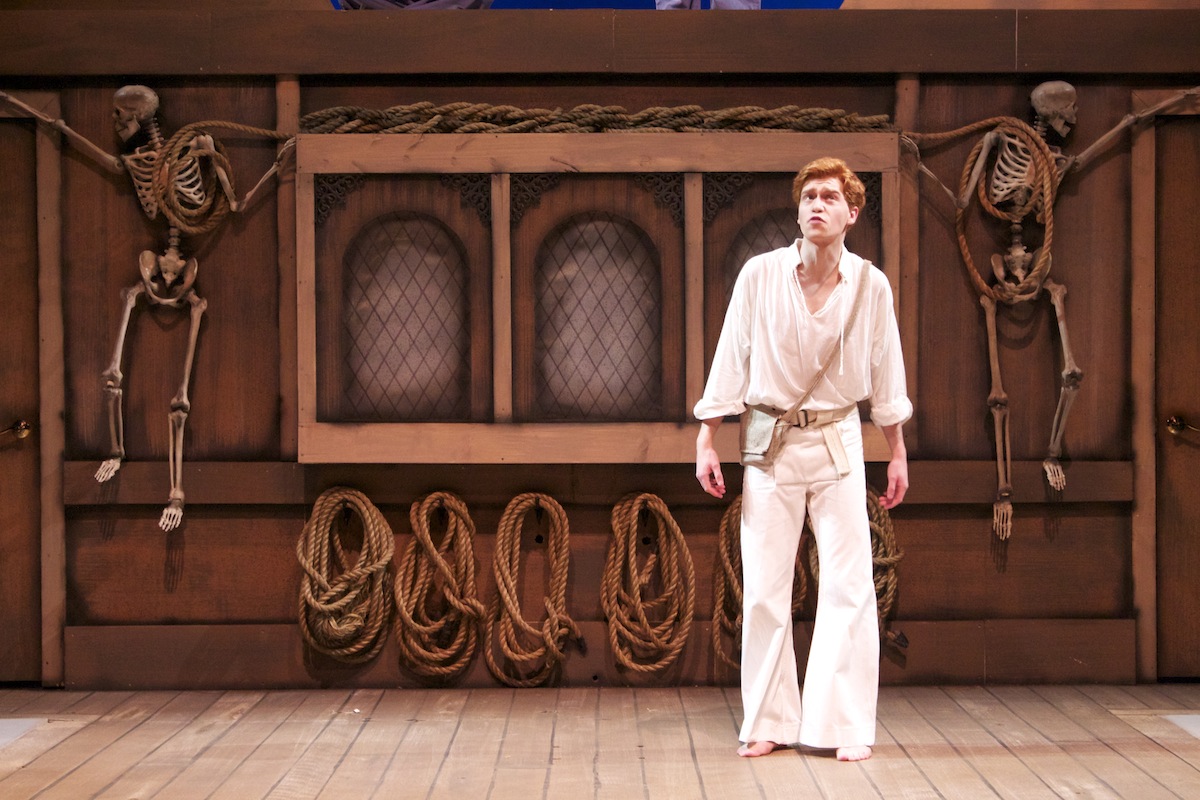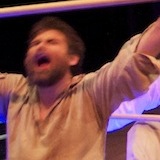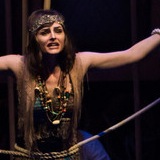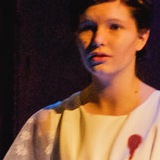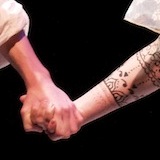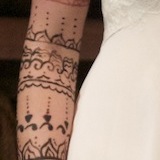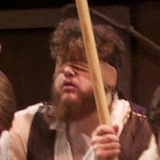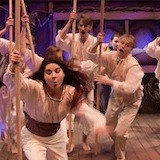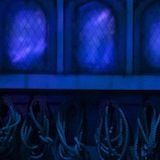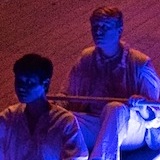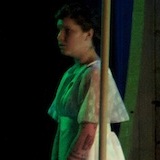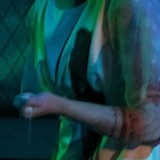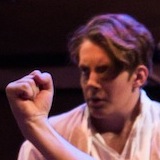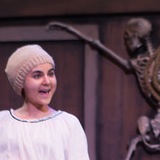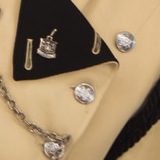Apollonius’ Argonautika
translated by Mary Zimmerman
Directed by Henry MacCarthy
The Anderson Theatre
Gustavus Adolphus College, St. Peter, Minnesota
Reviewed by Eric Dugdale and William Riihiluoma
Gustavus Adolphus College
“What was it like when the world was so young?” ask the actors of the Muse in the opening invocation of Mary Zimmerman’s Argonautika. It is a question that has continued to fascinate Zimmerman and her audiences ever since her dramatic retelling of Homer’s Odyssey first took to the boards at Northwestern University in 1989, where Zimmerman now teaches in the Department of Performance Studies. A 1998 recipient of a MacArthur Fellowship (a.k.a. “genius grant”), Zimmerman has become one of the most prominent interpreters of the classical tradition. Her Metamorphoses, premiered by the Lookingglass Theatre in 1998, went on to Broadway and earned Zimmerman the 2002 Tony Award for Best Director. Zimmerman is the original director of all her works, and her work with her company helps shape her plays.1
Argonautika, Zimmerman’s most recent classical play (premiered in 2007, also at the Lookingglass Theatre), stages the epic voyage of Jason and his Argonauts. It draws much from the homonymous poems of Apollonius Rhodius (3rd c. BC) and Valerius Flaccus (1st c. AD), in the translations of Peter Green and David Slavitt respectively.2 Hers is a close relationship with her sources, as she herself observes: “So I don’t set out to change them or quarrel with these texts; I’m more interested in a sort of loving dialogue with them.”3 Zimmerman is the consummate storyteller; she finds the imaginative core of an archetypal story and brings it to life. She strips down Apollonius’ poem, as Valerius did before her, thereby allowing fewer episodes greater room to breathe. (The show still lasts over two and a half hours.) And yet her play remains true to the spirit and style of Apollonius’ poem. At times it exudes epic grandeur and lyrical beauty. Like a number of Zimmerman’s other works (especially The Arabian Nights and Metamorphoses), it has a strong cosmological dimension that invites the imagination to enter into a primeval and elemental world at the dawn of time. The magnitude of this archetypal voyage of discovery is especially conveyed by Athena, who functions as a narrator framing individual episodes, as at the launch of the Argo (“At the Hours’ prompting, the Sun / put on his splendid tiara of shining rays and rose in the sky / to bedazzle the waves on the shore where the Argonauts slept. / From the town and down the mountains, everyone came, people / and creatures of all kinds, to see, at last, the launch ”)4 and again at the arrival at Samothrace (“The sun rose up and sank in the sky, / and then, for the first time since the world began, / a ship from foreign parts pulled up to foreign shores”).5
Like Apollonius and Valerius, Zimmerman writes in a range of registers. We see this variety in the gods, whose machinations and direct interventions aid Jason and his crew at every turn. At times Hera and Athena stand apart, pacing imperiously on the raised platform that serves as the theologeion and doubles as the bridge of the Argo; at times they blend in with the human characters, adopting a seemingly infinite variety of mundane disguises, a kind of shape-shifting perhaps inspired by Zimmerman’s earlier immersion in Ovid’s Metamorphoses. The effortlessness of divinity coexists with the frustrations of familial relations, and elevated language rubs shoulders with bathos. Aphrodite, a pampered housewife given to sarcasm, vents to Athena and Hera about her obstreperous son Eros as her cortege combs her hair and fans her. The humor of Apollonius’ portrayal of Aphrodite’s fraught relationship with her teenage son is preserved by Zimmerman. Aphrodite’s opening salvo, “What are you grinning at, you unspeakable little horror?”6 is an amped-up translation of Apollonius’ line (τίπτ᾽ ἐπιμειδιάᾳς, ἄφατον κακόν, 3.129).
Perhaps the greatest range is found in Hercules who, like Apollonius’ Heracles, often comes across as a buffoon and a self-absorbed, competitive, irascible windbag. He is a landlubber who gets seasick at the first pitching of the boat. At roll call, when the Argonauts take turns introducing themselves in a spoken-word version of an epic catalogue of heroes, he is unable to keep the beat or follow suit. Not only is composition-in-performance beyond him, but he also disrupts the team-building exercise, breaking into a fatuous refrain of “I’m Hercules! / Yeah! / I’m Hercules! / Yeah! / Hercules! Hercules! Hercules!”7 He even turns rowing into a competition to see who can row the fastest (Figure 1), as absurd a proposition for team rowing as it would be for orchestral performance.8 And yet his relationship with his beloved Hylas is tender, and his grief at losing him poignant and raw.
Apollonius’ poem is a masterpiece of Hellenistic erudition, at once closely intertextual and highly original; the same holds true for Valerius’ work.9 Zimmerman’s Argonautika follows suit, the latest contribution to an iterative process that goes back all the way to Homeric epic. It is a play whose subtleties a classicist can appreciate. For example, in Apollonius’ poem the heroine Atalanta, famous for her athletic prowess, is eager to enlist in the expedition, but is prevented by Jason, who “feared bitter rivalries provoked by love” (Argonautica 1.773). In other versions she is listed in the catalogue of Argonauts (cf. ps-Apollodorus, Library 1.9.17); Zimmerman follows this tradition by including her in the crew, but not without a wink at Apollonius:
ATALANTA:
My name’s Atalanta.
HERCULES [alone, belligerently]:
Yeah?
ATALANTA:
Think I’m out of place?
HERCULES:
Yeah!
ATALANTA:
Then just one question,
HERCULES:
Yeah?
ATALANTA:
Would you like to race?10
Later Zimmerman has Hercules engage in an epic battle with a sea-monster guarding Andromeda (Figure 2), much to the chagrin of Percy Jackson aficionados for whom this is one of Perseus’ crowning exploits. Is this a nod to Disney’s television series Hercules (1998), in which Hercules and Andromeda are students at the Prometheus Academy and the new girl asks the love-struck Herc on a date? Or is Zimmerman engaging in intertextual aemulatio with Valerius, whose Argonautica describes how Hercules saves the Trojan princess Hesione from a sea-monster sent by Poseidon? Certainly the episode follows Valerius’ version in a number of telling details. And Valerius is himself drawing on Ovid’s account of Perseus’ rescue of Andromeda in his Metamorphoses (Met. 4.663-752), thereby bringing us full circle.11 As in Valerius’ account, the focus in the modern play is not on the love interest between Hercules and the damsel he rescues, as in Ovid’s Perseus-Andromeda episode, but on Hercules’ prowess as a victor. In fact, Hercules forgets about the maiden he has saved in his excitement over his feat, and Andromeda must call out repeatedly “Untie me!” Further intertextual humor infuses this and other episodes. In Valerius’ version, Hesione promises Hercules her father Laomedon’s snow-white horses as reward for her rescue (2.485-8). Laomedon, however, invites Hercules to spend the night, adding that he will give him the horses in the morning (2.565-6); he intends to kill his guest in his sleep. But Hercules decides to press on, thus eluding death, promising to return to pick up the horses on the way back. In Zimmerman’s version, Hercules deftly sidesteps the death-trap before it even materializes:
ANDROMEDA:
Sir, my father has declared a great prize for anyone
that saves me and rids us of the monster:
a pair of dazzling snow-white horses!
HERCULES:
Horses? I’m with a boat right now.12
It seems this Hercules knows his Valerius and has also compared notes with Homer’s Telemachus, who in the Odyssey (4.600-8) turns down Menelaus’ gift of horses and chariot because they would be useless to him on rocky Ithaca. Zimmerman’s combination of erudition and intertextual humor is close in spirit to the Hellenistic aesthetic of Apollonius. Zimmerman’s method is an extension of Apollonius’ tradition of eclecticism and repurposing.
Zimmerman’s play is divided into two acts, mirroring the structure of the poems of Apollonius and Valerius, both of which announce a second movement through a second proem invoking the Muse (Apollonius 4.1-5, Valerius 5.217-9). In this second act the plot of the epic journey intersects with the story of Medea, who is coopted by Hera and Athena, aided by Aphrodite and Eros, to help Jason succeed in his quest. Zimmerman foregrounds the apparatus of divine manipulation, depriving Medea of some of her agency. Her tragic fate is foreshadowed through costuming: her white dress is stained with blood from the arrow with which Eros has pierced her heart, and every time Medea makes an entrance the blot is bigger (Figures 3 and 4). Similarly, echoes of Virgil’s Dido and Aeneas carried over from Valerius’ poem add to our awareness of impending doom. But the play’s arc continues to follow the journey of the Argo as its crew surmounts one challenge after another, now with the aid of Medea’s magic arts, and Medea becomes ballast discarded too readily. It is not that Medea’s pathos is trivialized. Rather, in the shadow of Euripides’ Medea, any retelling that does not languish in her pathos seems off kilter. The play ends where it began, with attention fixed on the Argonauts, who introduce themselves for a second time, now immortalized as the constellations of the zodiac.13 The star show ends with Medea, transformed into Virgo, the virgin goddess. The catasterism, a favorite Hellenistic trope, suits the play’s cosmological interests and story-telling register, but the “tidy bow”14 with which it ties up the play seems too neat in the wake of the devastation and carnage that we have just witnessed in double time.
Endings are always vexed, especially in Greek and Roman epic. Zimmerman has to strike out on her own because Valerius’ poem, her main source in the second act, is unfinished. This gives her the liberty to innovate to a greater degree than she has hitherto. She seems to acknowledge her modern contribution to the mythical tradition in an exchange between Hera and Athena in the closing scene, delivered as they replace Medea’s bloodied dress with a new one (Figure 5):
HERA [quietly, a little embarrassed]:
This dress has a zipper.
ATHENA:
I know.
HERA [again embarrassed]:
Not very authentic.
ATHENA:
No. But then... a sheep that flies? And a dragon who doesn’t sleep
and all the rest? Don’t be so literal. You miss a lot.15
The vagaries of transmission mean that Valerius’ poem breaks off while still incomplete. Medea intuits Jason’s perfidy, importunes him in language heavily redolent of Dido’s appeals to Aeneas in Virgil’s Aeneid (e.g., nulla fides? 8.435; heu dure siles? 459), and storms off in a Bacchic frenzy; as Jason vacillates on how to respond, the poem ends abruptly. The lack of closure—occasioned, we presume, by Valerius’ untimely death—is perhaps more satisfying to our modern sensibilities than the “happily ever after” (ἀσπασίως, 4.1781) ending of Apollonius.
The final two scenes of Zimmerman’s play show a metatheatrical self-awareness that problematizes the neat ending.16 For example, in their closing words the Argonauts offer a moral exemplum drawn from their own story:
ARGONAUTS:
Oh these glorious missions of men, they start out so well,
so full of hope and noble intent: teach the foreigner a lesson,
destroy the tyrant, become a man, defend the nation,
hip, hip, hoorah, hoorah. Seize that shining Fleece
and the world itself will change, seize that Golden Fleece
and utopia will descend, seize that Fleece and
there will be an end to evil.
Whatever.
They all end up like this in the end.17
This double vision has been present throughout the play. The Golden Fleece inspires poetic hyperbole and bathos alike. After setting Jason the quest of retrieving the Golden Fleece, Pelias delivers a blistering aside: “Who gives a fuck about the Fleece? Are you serious? Some stinking piece of wool that’s been rotting in the rain for twenty years?” And when Jason and Medea consecrate their marriage aboard the ship, then consummate it on the Fleece, Athena wryly notes: “Oh yes they did. Right there, on the Fleece itself!” This may be disorienting, and the crude humor may seem out of place in a play whose language is sometimes hauntingly beautiful. But the disjuncture lies at the heart of the subject matter itself; this is at once an archetypal story of heroic adventure and an egregious case of utter depravity. The play’s ending lives with this paradox. Jason, now an outcast, stumbles across the carcass of the Argo rotting on a lonely rocky outcrop; he contemplates hanging himself from the mast, but the wreck collapses and crushes him. “Not a glorious end,” adds Hera. “No,” Athena agrees. “What happened to the rest?” asks Hera? “Look up,” replies Athena: “There in the sky, the zodiacal signs that journey forever. All of them are there.”18
Zimmerman’s Argonautika revels in exploring the mythical world. The production at Gustavus Adolphus College, directed by Henry MacCarthy, makes the most of the fluidity afforded by the play’s lack of realism. MacCarthy sets the different worlds that the Argonauts visit in different time periods through stunning use of costuming and props (costume design by Natalicia ZumBerge). His women of Lemnos, for example, are dressed in clothing reminiscent of housewives of the 1940s, awaiting their husbands’ return. With their hair done up in victory rolls and their chanting in unison to the accompaniment of a guitar, they also conjure a comparison to the cults of the 1960s, à la Scientology or the Children of God. His Aphrodite is a 1950s housewife sporting a frilly magenta dress and garish costume jewelry, carrying a plate of cupcakes. Her son Eros, his spiked hair radiating an electric pink, wears a ribbed wife-beater vest, a studded leather choke collar and wrist bands (Figures 6a and 6b). Thus MacCarthy exploits the deliberate anachronism foregrounded at key moments in Zimmerman’s text. The audience accompanies the Argonauts on a journey of discovery in which they explore new worlds, and the different locations that the Argonauts visit are distinguished by the costumes of their inhabitants, separated in time and space.
Utilizing temporal separation in costuming to communicate the spatial distances involved in the plot not only solidifies the surreal quality of this story of heroes and monsters, but also allows for a certain level of visual storytelling. The Argonauts find Colchis a land subject to the iron rule of Aeetes. Ensconced in stiffly regal accouterments suggestive of imperial Russia, his stern rule is emphasized in his perfectly manicured appearance, from his spotless black boots to his rich red coat and brass buttons. These costuming choices reinforce the foreignness of these far-flung lands. The Argonauts wear differing shades of off-white and beige outfits, the only real commonality being their simple high-waisted canvas pants, complemented by differing loose-fitting shirts and the occasional tan vest or set of beige suspenders (Figure 7). This relative simplicity in tone and homogeneity in appearance allows them to enter the numerous radically different worlds on their journey without disrupting their individual stylistic palettes.
The costuming of the goddesses Hera and Athena is also very intentional on the part of MacCarthy. Wondering what aspects of human experience would seem unusual and exciting for the gods, he decided that splendor and majesty were commonplace for them—the banality of the everyday would be their exotic. These two goddesses thus never wear jewelry, fine dresses, or armor, instead donning the uniforms of tollbooth operators and retail workers, maids and nurses. In this way, they may also be seen as the custodians of the human race (Figures 2 and 8).
The production at Gustavus Adolphus College utilizes a thrust stage, dominated by the foredeck of the Argo and a raised poop deck (Figures 9 and 10) occupying the furthest reaches upstage (scenic design by Micah Maatman). The ship’s bow reaches almost to the audience, so that the Argonauts look out to the audience when scanning the horizon for distant lands. Upon the floor of the foredeck lie four large panels that can be lit from below in different colors (Figure 11). The façade of the pilothouse facing the audience has dual doors flanking three oval portholes (Figures 1 and 12), as well as two ladders granting access to the upper deck. These different components of the stage are used to great effect to separate the different locales, as Zimmerman’s play, like Athenian drama and Shakespeare, is a theatre of the imagination, given focus and structure by the characters’ actions and words. The portholes, for example, glow red and billow smoke to become the bulls in Aeetes’ test of Jason. The two sets of doors lead both to Pelias’ throne room and to Aphrodite’s abode, and the light panels in the deck serve as both the water beside the ship (Figure 11) and as the pool in which Jason washes himself in the forest where he meets Medea (Figure 13).
The definition of the stage also relies heavily on props, particularly the multivalent rods used most commonly as the oars of the Argo. From the cliff to which Andromeda clings (Figure 2) to the pillars in Aeetes’ court to the forests surrounding Colchis (Figure 14), these rods define the space while also loosening the audience’s inherent focus on place and highlighting the actions of the characters. The only clear division onstage is between the elevated poop deck of the Argo and the main deck. This separation often implies a great distance between the actions and characters on either deck, both literally and metaphorically. The poop deck often functions like the roof of the Athenian skene, serving as a platform from which gods oversee the action below. This distinction is put to good use in the production, as when Athena narrates the voyage of the Argo between destinations, or when Hera an Athena discuss the happenings in the mortal world below. This separation between gods and men is closed whenever the goddesses go down to interact directly with the mortals, as in the beginning of the play when Hera is carried across the river by Jason and his sandal is lost. The separation is also used to illustrate Aeetes’ divine heritage and his mindset: he never once departs from the upper stage, asserting his will from afar like a god detached from the mortal realm.
This play contains a very large number of characters, many of whose roles are quite small. The production at Gustavus thus heavily and intentionally utilized the idea of casting double roles to accentuate similarities between characters and their relationships. The actors playing Hercules and Hylas also played Aeetes and Apsyrtos respectively. Hylas’ and Hercules’ poignantly linked exits from the story are mirrored in their actors’ shared return to the stage as the royalty of Colchis. Hercules, a boastful and proud buffoon earlier in the show (Figure 15), is mirrored both in Aeetes’ extreme pride and antithetically in his elegant, flowing lines and cold demeanor. Hylas, at first Hercules’ quiet companion and supporter (Figure 16), is mirrored as well in Apsyrtos’ quiet, unequivocal devotion to his father and king (Figure 17). This multiple casting also suggests Athenian tragedy, in which the three-actor convention required the deuteragonist and tritagonist to play multiple characters, often leading to rapid costume changes backstage. This same logistical difficulty persists today; three members of the costume team help Medea change dresses, requiring considerable practice and a stopwatch in some cases.
The Gustavus production features original music composed by Aaron Bogen. All music but the tango accompanying the lovemaking on Lemnos is performed live, either on stage or just offstage. Instruments range from the body percussion performed by the Argonauts throughout the Roll Call scene to accompany the rap (choreographed by Kate Dudley) to Japanese taiko drums and the Ugandan amadinda, a sort of xylophone. The numerous pieces played both during scene transitions and within certain scenes—as in the scene at Aphrodite’s abode, in which saccharine elevator-type music plays in the background—all maintain a percussive element throughout. This focus on percussion creates a welcome consistency in a play that changes location and costuming so often.
Director Henry MacCarthy staged Zimmerman’s Arabian Nights in 2010, another play with a huge cast, exotic settings and costumes, a fantastical story, and an episodic structure that takes the audience on an imaginative journey into the past. What he admires about Zimmerman is that she “takes on gigantic epic stories and is completely fearless about it.” He too relished the challenge of taking on a play that “is in theory impossible to stage.”19 But MacCarthy and his crew, like Jason and the Argonauts, rose to the occasion.
notes
1 Zimmerman (personal communication, February 2, 2016) describes her creative process: “I think of myself primarily as a director, not a writer. I write the script during the same time frame as rehearsals, writing every night a day ahead of the actors (not, as some suppose, improvising with the actors and then “writing it down.”) The script is very influenced by the set we have designed, by the company I have cast — both those things precede the script.”
2 Zimmerman (personal communication, February 2, 2016) credits Slavitt as a significant creative influence on both her Metamorphoses and her Argonautika: “His profound love of the stories mixed with complete irreverence and creative meta-commentary was very, very influential to me from Metamorphoses on: the rapid shift in tone, the freedom in the telling, the wit... I came to stage Argonautika in large part because he had done a translation (albeit of the Roman version of the story).”
3 McConnell (2010), footnote 4, citing Mary Zimmerman on “Shakespeare Theatre Company” podcast, recorded February 15, 2007.
4 Zimmerman (2013) 37-8.
5 Zimmerman (2013) 48.
6 Zimmerman (2013) 95.
7 Zimmerman (2013) 28.
8 Apollonius’ version is less absurd, as the competition is to see who can outlast the rest (Argonautica 1.1153-4). In Valerius’ poem the crew members are keeping time but Hercules is competing to make the biggest waves (Argonautica 3.473-5).
9 See Hershkowitz (1998) 35-104 for a sustained treatment of the latter’s intertexts.
10 Zimmerman (2013) 31.
11 For Ovidian intertext in Valerius’ Hesione episode, see Hershkowitz (1998) 72-8. As Hershkowitz notes, Valerius’ imagery also draws from Virgil’s Aeneid, Seneca’s Phaedra, and the treatment of the Andromeda incident in Manilius’ Astronomica.
12 Zimmerman (2013) 50-1.
13 The proem (1.4) of Valerius’ Argonautika and two further allusions (at 1.1303-4 and 4.691-3) seem to anticipate a catasterism of the Argo towards the end (now lost) of the poem.
14 The phrase is borrowed from Tony Gomez, whose write-up of the performance for a class assignment offers a different response to the play’s ending: “However, the truly touching piece of the play is when all of the crew of the Argo appear onstage and explain their place in the constellations, and state how their journey is still recorded in the night sky for all to see. That last segment truly puts a tidy bow on the performance and teaches the audience about the constellations that most have knowledge of, but no understanding of the story of them.”
15 Zimmerman (2013) 143-4.
16 Henry MacCarthy, director of the Gustavus production, noted that the end brings the play back to the present, a transitional device from the narrative past also found in Zimmerman’s Arabian Nights (oral interview, November 10, 2015).
17 Zimmerman (2013) 141.
18 Zimmerman (2013) 146.
19 Both quotations from an oral interview with MacCarthy conducted on November 10, 2015.

